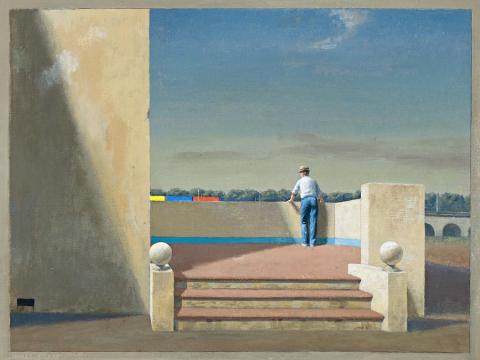STUDY FOR THE TERRACE, VARIATIONS ON A THEME, 1994
JEFFREY SMART
oil on canvas
45.0 x 60.0 cm
signed lower left: JEFFREY SMART
Philip Bacon Galleries, Brisbane (label attached verso)
Private collection, Queensland
Jeffrey Smart, Australian Galleries, Sydney, 6 April – 10 May 1995, cat. 20 (illus. in exhibition catalogue, label attached verso)
The Terrace, variations on a theme, 1994, oil on canvas, 59.0 x 80.0 cm, illus. in Allen, C., Jeffrey Smart Unpublished Paintings 1940–2007, Australian Galleries, Sydney, 2008, p. 211
Jeffrey Smart's exhibition at the Australian Galleries, Sydney in 1995 included a number of major works and their related studies. Among the portraits were fellow artist Margaret Olley as seen in the Louvre Museum together with two oil and pencil studies. There were five studies of Clive James. The subject paintings likewise included a number of studies, invariably important keys to the understanding and evolution of the 'finished' painting. I say 'finished' for so often the studies in oil are complete paintings in their own right. Study for The Terrace, variations on a theme is an example, chosen for illustration in the exhibition catalogue over the slightly larger painting, The Terrace, variations on a theme. The settings are the same. Shadows take on forms and colour contrasts create plenty of visual interest. They present Smart's evergreen involvement with isolation, the alienation and beauty of the modern urban world, and his consummate sense of composition.
The difference between the two paintings lies in the off-centre, in the figures - a bikini clad women seated on a red and white striped towel occupies the larger painting, replacing the standing man in the study. Sunglasses and a loose bikini top, she stares directly (enticingly is aword not found in Smart's iconography) at the viewer. The man is seen from the back, blue jeans harmonising with other objects of the same hue. The figure placements are exact, as props, as Smart is wont to say, to give scale for the rest of the picture. Neither they nor the artist utter a word. It is, of course, Smart at his enigmatic best. As Barry Pearce says in the 1995 exhibition catalogue, 'Jeffrey Smart is one of the most intriguing of Australian painters. He presents a world pervaded by visual ironies, but devoid of emotional engagement.'1
He does, of course, let on more than he admits. One example will suffice. All his life Smart has been a realist painter, remaining serene and silent, some might say, amid the turmoils of abstract expressionism, minimalism and just about every other ism you want to mention. He was not untouched. The 'blank' wall to the left of our painting is a wonderful piece of textural, abstract painting, a minimal painting within a painting. As Pearce observed in his mentioned essay,'... for the artist is simply saying that abstraction ... is a quality to be found in the commonplace world anywhere we care to look.'2 Smart looks widely and invites us to do the same.
1. Pearce, B., 'Revelation of the Seen', Jeffrey Smart, Australian Galleries, Sydney, 1995, p. 5
2. Ibid, p. 6
DAVID THOMAS
